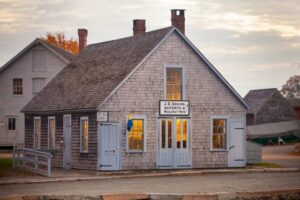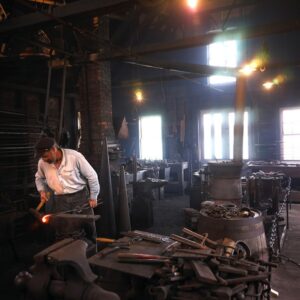This shipsmith shop was built at the head of Merrill’s Wharf (now Homer’s Wharf) in New Bedford, Massachusetts, by James D. Driggs in 1885. It is the only manufactory of ironwork for the whaling industry known to have survived from the 19th century.
 Driggs served his apprenticeship during the 1840s with the James Durfee Company, then the largest and most productive enterprise of its kind in New Bedford. He and another Durfee employee, Joseph Dean, established their own shop near Merrill’s Wharf in 1846, under the name of Dean & Driggs. The two smiths produced a good quality whalecraft–harpoons, cutting irons, ship’s fittings, etc.–in a successful partnership that lasted almost 30 years. Their shop, located in an alley that came to be known as Driggs Lane, was equipped with five forges and machinery run by power tapped from a neighboring flour mill. They employed as many as three journeymen at a time, one of whom was Lewis Temple, Jr., son of the black shipsmith who in 1848 invented the practical toggle harpoon which made capturing whales much more successful than it previously had been.
Driggs served his apprenticeship during the 1840s with the James Durfee Company, then the largest and most productive enterprise of its kind in New Bedford. He and another Durfee employee, Joseph Dean, established their own shop near Merrill’s Wharf in 1846, under the name of Dean & Driggs. The two smiths produced a good quality whalecraft–harpoons, cutting irons, ship’s fittings, etc.–in a successful partnership that lasted almost 30 years. Their shop, located in an alley that came to be known as Driggs Lane, was equipped with five forges and machinery run by power tapped from a neighboring flour mill. They employed as many as three journeymen at a time, one of whom was Lewis Temple, Jr., son of the black shipsmith who in 1848 invented the practical toggle harpoon which made capturing whales much more successful than it previously had been.
After Dean’s retirement in 1875, Driggs continued for 10 years in the Driggs Lane shop, probably at a reduced level of production. In 1885, with the whaling industry on the wane, and having himself reached the age of 65, Driggs relocated to the wharf (a move of only a few hundred feet) in a new, smaller shop that he built with his grandson’s help. This new shop, the one currently exhibited at Mystic Seaport Museum, served Driggs’ needs until 1902, when it was sold to Ambrose J. Peters. Driggs died shortly thereafter.
 Peters served his apprenticeship in the machine shops that served New Bedford’s textile mills, and when he purchased Driggs’ business in 1902, shipsmithing was a specialization that was not much in demand. He added a large ell to the rear of the shop (primarily for storage), and branched out into the lubberly pursuits of general blacksmithing. He was succeeded in this after his death in 1918 by his brother, Charles E. Peters. Although they were not the specialists that Driggs had been, the two Peterses continued in whalecraft manufacture when only a handful of whaleships–the Charles W. Morgan among them–were left in service. In fact, the shop was still operational for three years after the Morgan was retired. Merrill’s Wharf was the last outpost of Yankee whaling, and C.E. Peters was probably the last whalecraft manufacturer in America.
Peters served his apprenticeship in the machine shops that served New Bedford’s textile mills, and when he purchased Driggs’ business in 1902, shipsmithing was a specialization that was not much in demand. He added a large ell to the rear of the shop (primarily for storage), and branched out into the lubberly pursuits of general blacksmithing. He was succeeded in this after his death in 1918 by his brother, Charles E. Peters. Although they were not the specialists that Driggs had been, the two Peterses continued in whalecraft manufacture when only a handful of whaleships–the Charles W. Morgan among them–were left in service. In fact, the shop was still operational for three years after the Morgan was retired. Merrill’s Wharf was the last outpost of Yankee whaling, and C.E. Peters was probably the last whalecraft manufacturer in America.
After Charles Peters’ death, the shipsmith shop was sold by his widow in 1925 and placed on display at Round Hill, the estate of Colonel E.H.R. Green in South Dartmouth, Massachusetts, where the Charles W. Morgan was also exhibited. In 1944, the shop was brought to Mystic Seaport Museum to rejoin the Morgan, which had come three years earlier.


